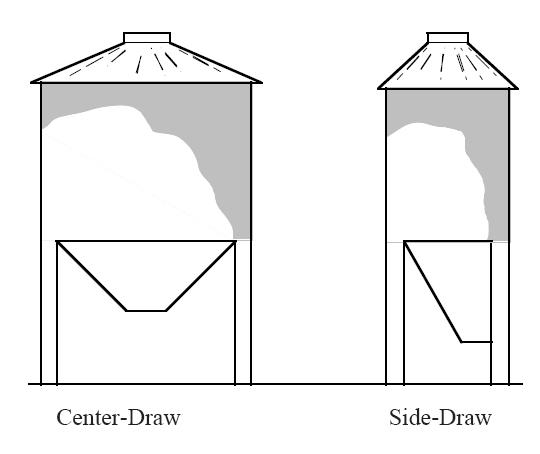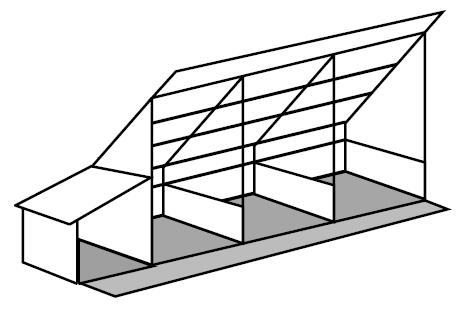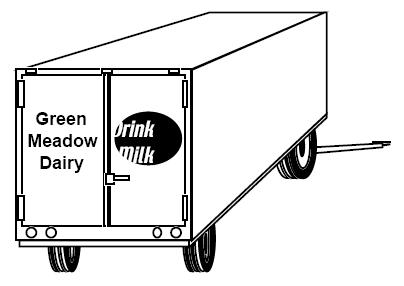Introduction
Various dry feedstuffs are included in typical dairy cattle rations. These may include dry grains, commercial grain mixes, and a host of by-products from feed and food processing operations. Whether you feed a commercial grain mix or use commodities such as bakery wastes, cottonseed, or brewers grain depends on your situation. As numbers of cows increase, the bulk storage and handling of these materials may provide savings in purchase price, handling, and feeding. The type and amount of these materials you will need to store depend on many factors. Prepare a feed budget for your farm comparing the costs and savings of using various feeds and the quantities of these feeds purchased at any one time. A cost analysis for the farm involves several aspects: storage, processing, loading, labor, interest on the investment, shrink, and maintenance on the facilities and equipment.
Please check this link first if you are interested in organic or specialty dairy production.
Storage Options
Depending on the materials and commodities, storage options include upright hopper bottom bins, flat storage bins, and liquid tanks (Figures 1 and 2). Hopper bottom bins permit gravity unloading of stored materials. There are two basic designs of these bins: side-draw and center-draw (Figure 1).

Figure 1. Hopper bottom bins (MWPS-7).
Side-draw hoppers are for materials that tend to bridge, such as concentrates and ground feeds. The steep side slopes allow these materials to flow more freely. Limit bulk feed tank capacity for off-center unloading bins to 20 tons. Center-draw bins work best for whole grain and free-flowing materials. Do not attempt to alter the discharge of the bin. This may compromise the structural integrity of the bin and cause failure.
Either a blower or an auger truck is needed, or an auger must be available on the farm to load materials into this type of storage. Short-legged bins may be positioned to discharge into a loader bucket or into an auger to elevate the material into a mixer wagon. Another alternative is to position the bin high enough to allow it to discharge directly into a mixer wagon. Locate the bin so it is convenient to the feed preparation activities.
Flat storages are usually concrete bottom bins with wooden, steel, or concrete walls to contain the stored material. Front-end loaders are used to remove material from the storage and load the mixer wagon. Direct access to the material with a front-end loader allows large quantities of material to be quickly and easily added to a feed mixer. When possible, the bins are designed and located to allow the delivery vehicle to unload the material directly into the appropriate bin.
Several of these bins may be located next to each other in a special open-sided building that is often referred to as a commodity shed or bulk storage building. Bins may also be built as part of a hay barn or other storage shed. In some cases, temporary bins can be fashioned using specially-built portable walls or even precast concrete highway barriers or large concrete blocks.
Convenient access to the bins for both loading and unloading is important. Flat storage commodity sheds are especially useful for materials that do not flow and cannot be moved with augers or stored in conventional bins where gravity flow is required. The inconsistency and unpredictability in handling characteristics of by-product ingredients make flat storage particularly useful.

Figure 2. Flat storage with separate area for bagged material.
Tank storage is necessary when liquid feed is used in the ration. An elevated tank with a pipe that discharges directly into the mixer wagon is simple and convenient. Ground-level tanks with a pump and an elevated discharge spout can also be used. Liquid can be drained from low tanks into a loader bucket and added to the mix, but most producers report this as unsatisfactory.
If feed mixing, receiving, or loading is done at night, consider yard lighting positioned to shine in each bin and to illuminate the area where the feed wagon is parked for loading. Position the lights so they do not interfere with normal operation of the loader or shine in the eyes of drivers maneuvering trucks.
Design of Flat Storage
There are many workable designs and layouts for flat bin storages. The size and type of the vehicle that will deliver materials, and how it will be unloaded, affect the design and layout of a flat bin storage system. Also, the number and amount of different materials to be stored need to be determined. To prevent old material from being buried in the back of a flat storage bin, an extra bin is required to provide a location for the next delivery.
If tractor dump trailers are to be unloaded directly into the bin, a high roof clearance and ability to back straight into the bin are a must. This explains why many commodity sheds have a steep monoslope with plenty of open space in front. Walking, floor-type vans need direct access to the bins, but because the bodies are not tipped up, they require less clearance. An alternative is to provide a large paved area in front of the bins for truck unloading. Remember that the material will spread out in all directions as it comes off the truck, so be sure to provide a sufficient clean paved area to prevent the feed from becoming contaminated with dirt or other debris. After the material is unloaded on the paved area, it is transferred into the bin by front-end loader. This method can be used to reduce the clearance needed for both maneuvering and dumping. It also may allow material to be piled higher in the bin. Hopper bottom trailers require a pad to dump onto with subsequent push-in with a loader.
Each of these has advantages. By pushing the feed into the shed, you can lower the roof and perhaps provide more protection to the feeds. However, dumping directly into the bin eliminates the need of a loader operator to store the feed.
Construction techniques also vary. Precast or poured-in-place concrete walls can be used and then a roof built on top of the walls. Or a post-frame building can be built and the lower walls reinforced with planks or concrete.
Whatever the roof design or wall type, the building must withstand the load of the product and the loads caused by loader tractors pushing into the walls. Reinforced concrete walls are expensive but provide the best protection. Concrete will also better withstand the abuse from corner blows with loader buckets or truck tailgates banging against them.
Sizing
Whatever the storage option, the amount of storage needed for a particular ingredient will be a multiple of the unit truck capacity plus a cushion of 25 to 50%, depending on the purchasing and transportation arrangements and whether replacement material will be dumped in the same bin that is being fed out.
A semitrailer truck’s capacity is about 24 tons. For dense products such as grain, cottonseed, soybean meal, and pelleted ingredients, one truckload will nearly equal the semi’s weight capacity. For less dense products such as brewers and distillers grain, experience shows that truck volume is the limiting factor; the load will contain about 20 to 22 tons of material. For maximum flexibility, size the bin to hold the maximum truckload capacity you expect to receive. If you plan on taking railroad car shipments, the bin size should be based on the largest rail car you expect to receive.
For sizing upright grain bins, the choice is limited to bin sizes available from suppliers. However, sizing flat bin storage takes some planning. In addition to holding the appropriate volume and weight of material, it must be sized and located to accommodate the delivery vehicles. A minimum width of 14 feet is required to allow easy loading and unloading of the bins. Remember that clearance will be needed alongside the trucks to safely open tailgates or end doors. A 16-foot roof clearance is recommended, with a minimum of 14 feet. Make reinforced wall height at least 6 to 8 feet. When dumping directly from the truck, a maximum depth of 6 to 8 feet could be expected. However, if material is to be pushed up with a loader, the maximum depth is limited only by the reach of the loader and the tenacity of the loader operator. Reinforced walls will need to be higher and strong enough to support the additional loads imposed by the loader and the deeper pile of material.
Most operators find it convenient to have more bins than the number of commodities they feed. Two extra bins seem to be the general rule. This allows room for storing a farm-made pre-mix, an extra load at a good price, or a fresh load while using the remainder of an older load.
|
Commodity |
Density lb/ft3 |
Storage Volume Required, ft3/ton |
|---|---|---|
|
Alfalfa, chopped |
12 |
167 |
|
Barley, whole |
38 |
53 |
|
Barley, ground |
28 |
71 |
|
Beet pulp, dried |
15 |
133 |
|
Brewers grain, dry |
15 |
133 |
|
Brewers grain, wet |
45-50 |
40-44 |
|
Concentrates, typical |
45 |
44 |
|
Corn, ear |
28 |
71 |
|
Corn and cob meal, dry |
36 |
56 |
|
Corn, shelled |
45 |
44 |
|
Corn, ground shelled |
38 |
53 |
|
Cottonseed, whole |
26 |
77 |
|
Cottonseed meal |
38 |
53 |
|
Distillers grain, dry |
15 |
133 |
|
Gluten feed |
33 |
61 |
|
Hominy meal |
28 |
71 |
|
Malt sprouts |
15 |
133 |
|
Meat scraps |
34 |
59 |
|
Mineral ingredients |
72 |
28 |
|
Molasses |
77 (10 lb/gallon) |
26 (200 gallons/ton) |
|
Oats, whole |
26 |
77 |
|
Oats, ground |
18 |
111 |
|
Soybeans, whole |
48 |
42 |
|
Soybean hulls |
16-18 |
111-125 |
|
Soybean meal |
42 |
48 |
|
Soybean screenings |
35 |
57 |
|
Total mixed ration (TMR) |
35 |
57 |
|
Wheat, whole |
48 |
42 |
|
Wheat, ground |
43 |
47 |
|
bran |
13 |
154 |
|
Wheat middlings (standard) |
20 |
100 |
|
Pellets, mixed feed |
35-40 |
50-57 |
|
Pellets, ground hay |
38-45 |
44-53 |
Often commodity sheds are used for storage of items other than feed. Fertilizer, lime, and bedding can be stored here quite easily. If this is a planned management practice, additional room and bays will need to be designed into the system.
Table 1 gives storage requirements for common commodity feeds. Use these values to determine the volume (ft3) needed for storage. Once the volume is known, determine the size of the bins required.
Example
Determine the bin size required for a semi load of whole cottonseed.
Solution
Assume the semi capacity is 20 tons, storage volume required from table is 77 ft3/ton, allow 30% extra storage, bin width is 14 feet, and storage depth of 6 feet. 20 ton x 77 ft3/ton x 1.3 = 2,000 ft3 Total volume required ÷ bin width ÷ depth = bin length. 2,000 ft3 ÷ 14 ft ÷ 6 ft = 24 ft. Therefore, the bin must be at least 24 feet long plus 5 to 10 feet for the sloping front of the pile. For open-front buildings, an extra 8- to 10-foot overhang may be necessary to protect the feed from rain and snow. Alternatively, a cover can be placed over the front portion of the feed for protection. Type of material, exposure of the building, expected weather conditions, and rate of feed-out will influence steps taken to protect stored material in open-front buildings.
Micro Items
Another important decision is the storage of medium-volume or micro items. Needed amounts of items such as minerals, salts, and calf grain may not be large enough for bulk storage. However, they may still constitute a considerable number of bags that need to be stored and handled close to the feed center. A common solution is to use one bay of a commodity shed. This tends to be a waste of expensive bin space. A better solution may be a small shed with a gravel floor to store items on pallets. This may be attached to or located close to the commodity bins (Figure 2). A van body or small portable building may also be used (Figure 3). Used van bodies are often inexpensive and can be readily moved when their function changes.
Plan storage areas for medium- and small-volume items to allow handling by pallet and forklift for increased convenience. Some ingredients may be available in mini-bulk 1,000-pound bags. These bags are typically handled with a forklift or chain-and-bucket loader.
Management
Additional management is required to achieve the maximum benefit from bulk purchase and handling of feedstuffs. When dealing with commodities and brokers, you become responsible for quality control and inspection of received materials and protection during storage. Most of the time, you receive each load of an ingredient from a new truck driver, who may not know your operation and may be unaccustomed to hauling feeds. Here are some ways to help ensure a good outcome from your delivery:
- Provide a good access route to your commodity barn. Consider that truck drivers spend most of their time going forward on pavement, not backing among farm buildings and machinery.
- Label your commodity bins. Location of ingredients may change from time to time, and labeling allows everyone involved a chance to double check.
- Provide convenient access to a truck scale.
- Expect the unexpected. Loads scheduled for Friday afternoon may arrive Friday evening or night. Some commodities are available seasonally. Forward contracting may be required for year-round feeding. Commodities are also hard to get during year-end holidays. Schedule deliveries before Thanksgiving, if possible. This is a time when extra storage space in the shed can be handy.
A carefully planned, well-constructed, and properly managed bulk storage facility can improve day-to-day dairy feeding operations and affect the profitability of your dairy farm. Commodity and by-product feeding is often a viable cost-saver, even for smaller herds. However, an interest in the feeding program by the manager is a must.

Figure 3. Van body on running gear for storing bagged materials.
Typical Bulk Storage Sheds

Author Information
John T. Tyson, Agricultural Engineer, Erie County
Robert E. Graves, Professor, Agricultural and Biological Engineering
